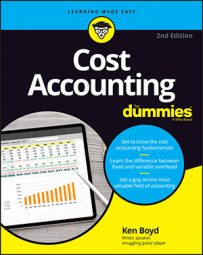In cost accounting, you categorize customer costs by cost pools. For example, vehicle costs (repair, maintenance, and insurance costs) are combined into a cost pool. Next, you trace or allocate the cost pool, based on a cost level (unit, batch, or company division). Finally, you consider the activities that lead to costs.
Ultimately, your goal is to understand what activities are causing costs for the company. You use that knowledge to reduce or eliminate the activities that create those costs for you — not that you can always do this. Now let’s isolate some of those activities and costs.
Say you own a catering business. You’re reviewing three clients who all purchased the same catering product in December — a dinner with dessert, served to 50 people. You charged $30 per person. This table lays out three cost variables that differed among these customers.
| Activity | Cost Driver |
|---|---|
| Purchase discount | Judgment by owner |
| Food delivery | $3 per delivery mile |
| Staff at event | $30 per hour per person |
The next table displays the dollar amount of costs for three customers.
| Client | A | B | C |
|---|---|---|---|
| Revenue | $1,500 | $1,500 | $1,500 |
| Food cost | –$1,000 | –$1,000 | –$1,000 |
| Discount | –$75 | $0 | –$150 |
| Delivery | –$60 | –$120 | –$75 |
| Staff time | –$120 | –$150 | –$135 |
| Profit | $245 | $230 | $140 |
Huh? What’s happening? Client C received the largest discount (10 percent) but generated the least profit ($140). Start to pull apart this second table. The revenue and food costs are the same for each client. That makes sense, because you’re providing the same product (50 meals at $30 per meal).
Consider the discount. Client A received a 5 percent discount; Client C was given a 10 percent discount. Why? The salesperson’s goal was to get the order from Client C — that’s one reason. The other motivation is to get more (or larger) orders in the future.
You can’t look at one catering event and determine if the discount paid off. Consider the whole year, or the next year. Does the client purchase more catering services (hopefully, yes)? Do those events generate any extra costs (hopefully, no)? These questions illustrate why offering a discount is a risk. You give up profit now in the hope that you’ll make it up with more business down the road.
Your delivery cost is driven by cost per mile. You can’t control how far away an event is; however, consider whether or not you need to make any extra trips. If so, you need to coach your client in advance to be prepared for an additional cost. That can be put into your catering contract. Something like “Any extra trips to the catering event will be assessed a cost of . . .”
You’ve determined that this type of event typically lasts two hours and requires two staff people to handle the catering. So you’d expect a staff cost of $120 ($30 per hour x 2 hours x 2 people). Two clients required more time. Again, ask, “Why?” Did the customer make unusual demands?
Labor cost is another opportunity to train your client in advance. Explain and document in the catering contract how you handle extra time incurred. At what point is a customer billed for that service? Can your staff stay an extra 15 minutes without charging? Thirty minutes? Think through all of this before you market to clients.
Client A was the most profitable. That client was given a small discount ($75). It happened to generate the lowest food delivery cost ($60). Well, it might just be luck that it was the closest location. Finally, it had the lowest staff cost ($120).
There’s a lot of food for thought (no pun intended) in the last table. Think about that discount issue and how to recover costs for extra delivery and staff time expense, with no “ups” and “extras.”

